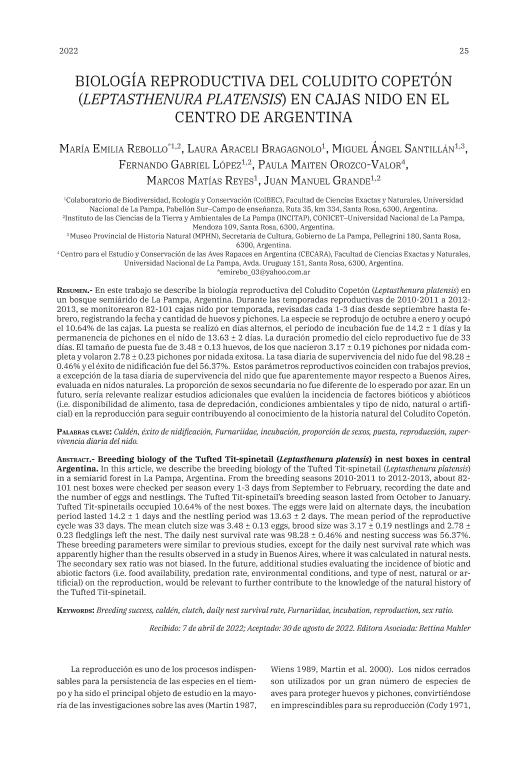Artículo
En este trabajo se describe la biología reproductiva del Coludito Copetón (Leptasthenura platensis) en un bosque semiárido de La Pampa, Argentina. Durante las temporadas reproductivas de 2010-2011 a 2012- 2013, se monitorearon 82-101 cajas nido por temporada, revisadas cada 1-3 días desde septiembre hasta febrero, registrando la fecha y cantidad de huevos y pichones. La especie se reprodujo de octubre a enero y ocupó el 10.64% de las cajas. La puesta se realizó en días alternos, el período de incubación fue de 14.2 ± 1 días y la permanencia de pichones en el nido de 13.63 ± 2 días. La duración promedio del ciclo reproductivo fue de 33 días. El tamaño de puesta fue de 3.48 ± 0.13 huevos, de los que nacieron 3.17 ± 0.19 pichones por nidada completa y volaron 2.78 ± 0.23 pichones por nidada exitosa. La tasa diaria de supervivencia del nido fue del 98.28 ± 0.46% y el éxito de nidificación fue del 56.37%. Estos parámetros reproductivos coinciden con trabajos previos, a excepción de la tasa diaria de supervivencia del nido que fue aparentemente mayor respecto a Buenos Aires, evaluada en nidos naturales. La proporción de sexos secundaria no fue diferente de lo esperado por azar. En un futuro, sería relevante realizar estudios adicionales que evalúen la incidencia de factores bióticos y abióticos (i.e. disponibilidad de alimento, tasa de depredación, condiciones ambientales y tipo de nido, natural o artificial) en la reproducción para seguir contribuyendo al conocimiento de la historia natural del Coludito Copetón. In this article, we describe the breeding biology of the Tufted Tit-spinetail (Leptasthenura platensis) in a semiarid forest in La Pampa, Argentina. From the breeding seasons 2010-2011 to 2012-2013, (2010-2011 to 2012-2013), about 82-101 nest boxes were checked per season every 1-3 days from September to February, recording the date and the number of eggs and nestlings. The Tufted Tit-spinetail’s breeding season lasted from October to January. Tufted Tit-spinetails occupied 10.64% of the nest boxes. The eggs were laid on alternate days, the incubation period lasted 14.2 ± 1 days and the nestling period was 13.63 ± 2 days. The mean period of the reproductive cycle was 33 days. The mean clutch size was 3.48 ± 0.13 eggs, brood size was 3.17 ± 0.19 nestlings and 2.78 ± 0.23 fledglings left the nest. The daily nest survival rate was 98.28 ± 0.46% and nesting success was 56.37%. These breeding parameters were similar to previous studies, except for the daily nest survival rate which was apparently higher than the results observed in a study in Buenos Aires, where it was calculated in natural nests. The secondary sex ratio was not biased. In the future, additional studies evaluating the incidence of biotic and abiotic factors (i.e. food availability, predation rate, environmental conditions, and type of nest, natural or artificial) on the reproduction, would be relevant to further contribute to the knowledge of the natural history of the Tufted Tit-spinetail.
Biología reproductiva del Coludito Copetón (Leptasthenura platensis) en cajas nido en el centro de Argentina
Título:
Breeding biology of the Tufted Tit-Spinetail (Leptasthenura platensis) in nest boxes in central Argentina
Rebollo, María Emilia ; Bragagnolo, Laura Araceli; Santillan, Miguel Angel; López, Fernando Gabriel
; Bragagnolo, Laura Araceli; Santillan, Miguel Angel; López, Fernando Gabriel ; Orozco Valor, Paula Maiten
; Orozco Valor, Paula Maiten ; Reyes, Marcos Matías; Grande, Juan Manuel
; Reyes, Marcos Matías; Grande, Juan Manuel
 ; Bragagnolo, Laura Araceli; Santillan, Miguel Angel; López, Fernando Gabriel
; Bragagnolo, Laura Araceli; Santillan, Miguel Angel; López, Fernando Gabriel ; Orozco Valor, Paula Maiten
; Orozco Valor, Paula Maiten ; Reyes, Marcos Matías; Grande, Juan Manuel
; Reyes, Marcos Matías; Grande, Juan Manuel
Fecha de publicación:
08/2022
Editorial:
Asociación Ornitológica del Plata
Revista:
El Hornero
ISSN:
0073-3407
Idioma:
Español
Tipo de recurso:
Artículo publicado
Clasificación temática:
Resumen
Palabras clave:
Tufted Tit-spinetail
,
Leptasthenura platensis
,
La Pampa
,
Furnariidae
Archivos asociados
Licencia
Identificadores
Colecciones
Articulos(INCITAP)
Articulos de INST.D/CS D/L/TIERRA Y AMBIENTALES D/L/PAMPA
Articulos de INST.D/CS D/L/TIERRA Y AMBIENTALES D/L/PAMPA
Citación
Rebollo, María Emilia; Bragagnolo, Laura Araceli; Santillan, Miguel Angel; López, Fernando Gabriel; Orozco Valor, Paula Maiten; et al.; Biología reproductiva del Coludito Copetón (Leptasthenura platensis) en cajas nido en el centro de Argentina; Asociación Ornitológica del Plata; El Hornero; 37; 1; 8-2022; 25-35
Compartir
Altmétricas



